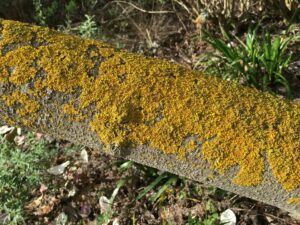The Secret World of Lichens
Lichens
A Secret World

If you look closely at trees, at the branches and twigs, at rocks and even soil, there you will find a world full of lichen – in shapes and colours, that resemble a miniature coral reef.
Lichen grow in virtually every terrestrial environment worldwide and have many important functions. They are food, camouflage and nesting materials for many animals. They are an important part of of the nutrient cycle, particularly by adding nitrogen to soil that can be used by other organisms. Some species that grow on soil prevent erosion.

Illustration at the top – A type of Crustose Lichen
Illustration above – A type of Fruticose Lichen
They are composite organisms, made up of a fungus and one or more algae, living together in the Lichen body. The algal partner produces essential nutrients for the fungus by photosynthesis (the process by which green plants and certain other organisms transform light energy into chemical energy). The fungal partner provides the body in which the algae live, providing protection from extreme conditions of heat or drought. The three major types of Lichen growth are Crustose, Foliose and Fruticose.

A type of Foliose Lichen
Lichen are highly sensitive to subtle changes in environmental conditions, ESPECIALLY air pollution, so they are natural indicators of the health of our air. The main pollutant affecting Lichen today is acid rain and nitrogen compounds from intensive farming activities. Ancient woods are particularly important to Lichen as they provide an undisturbed environnment, and a woodland is a good place to start Lichen spotting!
Further reading: The Secret World of Lichens by Troy McMullin
Harriet English